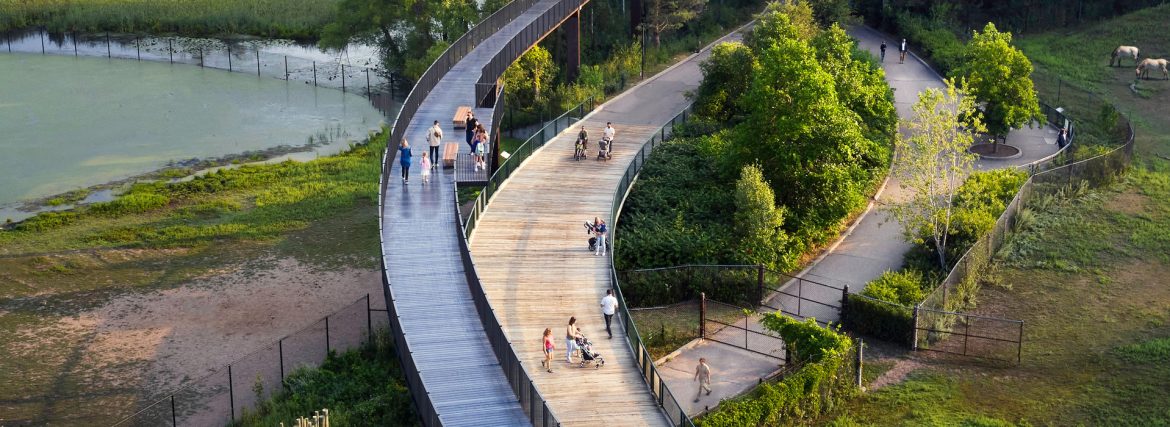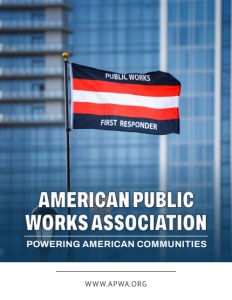Powering American Communities
Supporting the industry that keeps American cities safe, clean and working efficiently
In an era where infrastructure and public services shape the quality of modern life, the American Public Works Association (APWA) operates as an essential force in supporting and advancing the professionals who maintain the backbone of American communities.
In an era where infrastructure and public services shape the quality of modern life, the American Public Works Association (APWA) operates as an essential force in supporting and advancing the professionals who maintain the backbone of American communities. With 32,000 members across the United States and Canada, APWA has established itself as the premier organization for public works professionals, offering comprehensive support from career development to legislative advocacy.
“APWA works to support and promote the people who work in the public works industry,” explains Dominick A. Longobardi, APWA President. “We’re with you from toothbrush in the morning to toothbrush at night. From the minute you turn on the water that somebody in public works is helping provide to the minute you brush your teeth and shut off the light and go to bed, we’re with you.”
The association’s influence extends beyond daily operations into strategic planning and policy development. “We want to be the go-to organization for everybody so we can provide the education and advocacy our members need to do their jobs better; from local governments up to the federal government,” Longobardi says.
The Unseen Impact of Public Works
Behind these essential services are dedicated professionals whose work often goes unnoticed but proves vital to community functioning. “You walk out on a street that somebody from public works designed and built, you look at a tree that was planted by somebody from public works,” Longobardi notes.
Public works’ comprehensive reach encompasses critical infrastructure management and community development. The association’s influence goes far beyond traditional maintenance roles, shaping how cities and towns adapt to changing needs. APWA members tackle everything from clean water management to urban planning, demonstrating the field’s expansive scope. Public works professionals serve as the foundation of modern urban life, maintaining systems that residents rely on daily.
“Our members are the people who do everything for you every day to improve your quality of life,” Longobardi emphasizes. “We want to help the people who make the quality of life better for the people they serve.” The organization’s support system includes education, advocacy, and professional networking opportunities designed to enhance member capabilities and career growth potential. Through these initiatives, APWA strengthens the public works sector while ensuring communities receive high-quality service.
The organization places particular emphasis on career development and professional growth. “We want to make sure that from the time you start to the time you finish your career in public works, we have the ability to help you achieve the goals you want to achieve along the way,” Longobardi explains, pinpointing a focus on long-term career support that helps create a skilled workforce capable of meeting evolving infrastructure challenges while maintaining essential community services.
Public Works as First Responders
The critical role of public works professionals during emergencies often flies under the radar, yet these dedicated workers prove essential in crisis response and recovery. APWA has championed recognition of public works professionals as first responders, a designation that acknowledges their vital role in emergency situations. Longobardi explains their unique position: “If police and fire have to get in to help save someone’s life and they need that road cleared, we’re there helping them do that.”
Public works teams operate on what Longobardi describes as the FILO principle – First In, Last Out. “Public works first responders are first in and last out because we’re there opening the roads, clearing out things, paving the way so that somebody else can get through to do the job that they have to do. But then we’re also there cleaning it up afterwards.” This principle applies to both natural disasters and community events, showcasing the versatility of public works professionals.
The role also touches on everyday community support. “Just something as simple as a street fair,” Longobardi notes. “Usually, the ambulance corps is there or the fire department’s there, and the police department is there helping to secure that location. But we’re the ones providing the garbage trucks at the end of the street, or we set up the barriers to help secure street access.”
This recognition has gained momentum at various government levels. “Our chapters are now advocating on behalf of their members to state officials and governors’ offices or state legislatures,” Longobardi says. The effort has already yielded results, including a 2019 U.S. Senate resolution recognizing public works professionals as first responders. Following the September 11 attacks, President Bush officially acknowledged their first responder status through a presidential declaration, marking a significant milestone in recognizing these essential workers.
Building Tomorrow’s Workforce
Workforce development ranks among APWA’s most pressing priorities, reflecting broader challenges across industries nationwide. The organization has evolved its approach, moving past basic skill training to focusing on comprehensive career development. “We’ve moved beyond training you on how to put up a light pole or how to fill a pothole,” Longobardi explains. “We want to be there for you so we can help you build a career in public works.”
APWA’s innovative partnerships reinforce its workforce expansion mission and encourages chapters and members to mirror this goal. Where Longobardi is the Deputy Town Comptroller/Director of Purchasing for the Town of Hempstead, New York, a collaboration with Nassau Community College exemplifies the practical approach to training. “We’ve partnered with several trade unions, the local community college and the NAACP,” says Longobardi. “We’re actually building a new school at the college. We got $5 million out of the state, and that school is going to do everything from basic welding, basic mechanics, right up to wind power.”
APWA also recognizes the importance of adapting to different generational preferences and motivations. “It has to do with understanding generations and the generational workforce,” Longobardi notes. “The young kids coming out of school today, what motivates them and what makes them want to do certain things, and how do we adapt our program so that we can reach them and make them want to have careers in public works?”
This multi-faceted approach includes the development of targeted programs like the Emerging Leaders Academy and various mentoring initiatives. The organization also partners with other professional associations through the Engineering Workforce Consortium, addressing specific industry needs such as water plant operations.
Diversity and Inclusion in Public Works
APWA’s approach to diversity, equity, and inclusion intertwines closely with its workforce development initiatives, creating a more inclusive industry environment. The organization has launched several targeted programs, including Women in Public Works, to broaden participation across traditionally underrepresented groups. Through these efforts, APWA aims to transform public works into a more accessible career path for all interested individuals.
Partnerships play a crucial role in advancing these objectives. By collaborating with organizations like the American Council of Engineering Companies (ASCE) and the American Society of Civil Engineers (ACEC), APWA expands opportunities in engineering fields where women have made significant progress. “There was a big push to have more women join the field because they realized they’re not getting the brain power,” Longobardi explains. “There are a lot of people out there who could do all of these jobs.”
The organization’s veteran outreach program represents another vital component of its inclusivity efforts. “We never had really focused on this group before,” Longobardi notes. “We realize we have a lot of veterans coming out of the military who don’t have jobs or are looking for jobs. It’s a perfect mesh for what we do and what they probably did in the military in many cases.” This initiative supports veterans and brings valuable skills and experience into the public works sector.
“DEI is about including everybody who wants to serve in their community,” Longobardi emphasizes. “It’s making sure we’re giving you the opportunities so that you can make a career for yourself.” The organization views diversity and inclusion as essential components for building a robust workforce capable of meeting future infrastructure challenges while serving increasingly diverse communities.
Shaping Policy from Main Street to Capitol Hill
APWA maintains a powerful advocacy presence across all levels of government, from local municipalities to federal agencies. With five dedicated staff members in its Washington D.C. office focusing on government affairs, the organization develops comprehensive public policy priorities centered on three key areas: emergency management, transportation, and water resiliency. “For every new Congress, we review these policies and our priorities,” Longobardi explains.
The organization’s board includes 17 members, with six technical directors overseeing teams of volunteer experts who shape policy statements on crucial issues, including emerging technologies, like AI. These expert committees ensure APWA’s advocacy efforts accurately mirror industry needs. “When we actually go out and submit our policy priorities, they are what our industry needs,” Longobardi says. “One of our guiding purposes is to advocate on behalf of public works and the public works industry.”
APWA’s influence similarly reaches deep into local governance through its 62 chapters across the United States and Canada. Each chapter has designated advocacy ambassadors who work at various governmental levels. “Whether it be from a local village right up to the governor of the state that they’re in, promoting all of the different things that we need,” Longobardi notes. The organization also creates policy maker primers, providing crucial guidance to decision-makers at all levels.
The association’s rapid response capabilities further strengthen its advocacy impact. “Recently, we got a phone call from the White House, they needed somebody to testify in Congress,” Longobardi shares. “We try to be ready at a moment’s notice to provide the information that the government leaders need.” This readiness ensures public works perspectives are represented in critical policy discussions affecting infrastructure and community development.
The Road Ahead: APWA’s Vision for the Future
Looking ahead, APWA has identified three primary areas of focus that will shape its efforts over the coming years. Workforce development remains at the forefront, with particular attention to building sustainable career paths in public works. The organization’s second priority centers on expanding diversity, equity, and inclusion initiatives, while maintaining strong advocacy efforts round out their top priorities.
These strategic focuses show the evolving nature of public works and its essential role in community development. The organization’s efforts to adapt to modern challenges are exemplified by innovative projects across the country that are showcased by the Engineering & Public Works Roadshow. “We had one just recently at the Javits Center in New York where they’re growing food on the top of the Javits Center,” Longobardi says. “They’ve created all of this ability working with other non-for-profits to create food to provide for food banks.”
Similar innovation appears in Washington D.C.’s approach to workforce development. “Washington D.C. took over a high school and they built a school to train people in the public works industry,” Longobardi notes. “The district is hiring those people right out of that school.” These initiatives showcase how public works continues to evolve and adapt to meet community needs.
The organization maintains its focus on helping public works professionals serve their communities effectively while preparing for future challenges. Public works professionals must constantly adapt to new situations, from managing traditional infrastructure to implementing innovative solutions for emerging challenges. “Public works has to adapt every day,” Longobardi explains. “When we look at what’s important for the future, it’s having people who know how to do adapt, having people who want to do it, having people who have the drive to make it better, and how APWA can help them do that.”
AT A GLANCE
Name: American Public Works Association (APWA)
What: National organization representing public works professionals, providing education, advocacy, and professional development
Where: Headquartered in Kansas City
Website: https://www.apwa.org/


